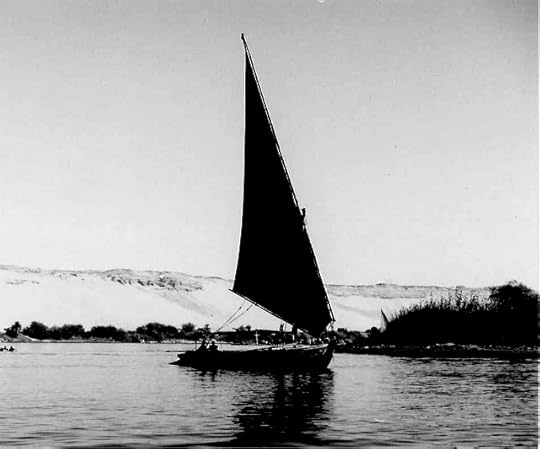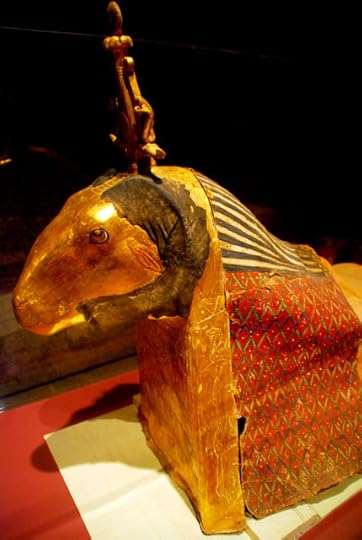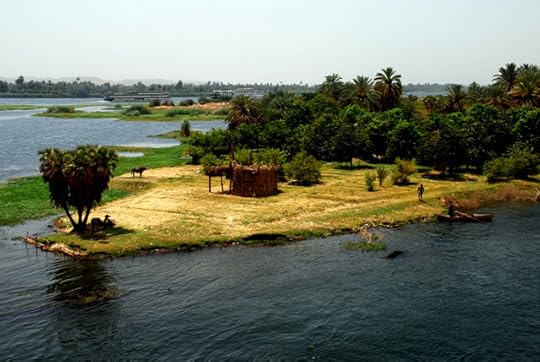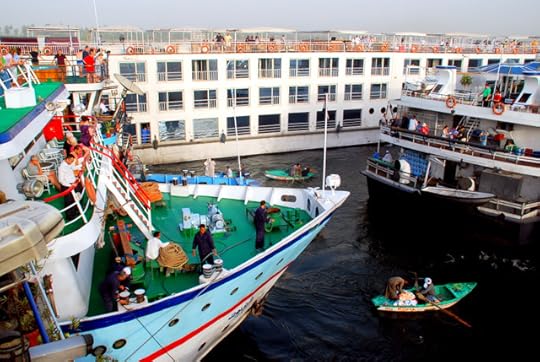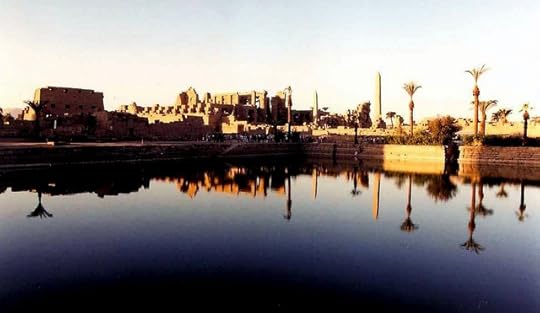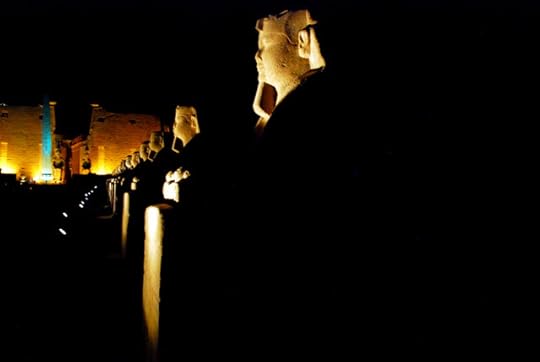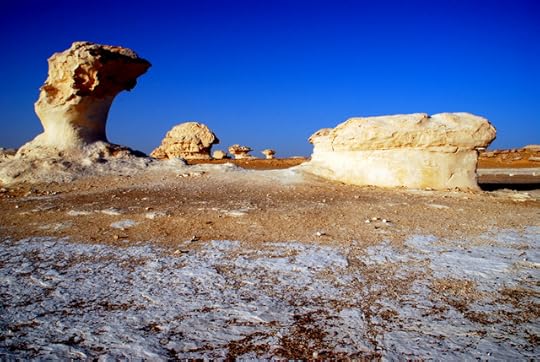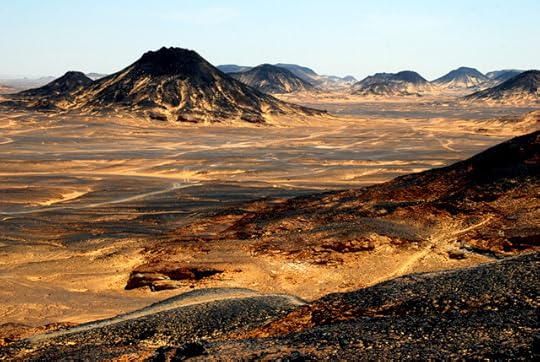Roderick Phillips's Blog, page 7
May 17, 2014
Visa hell and felucca fun, Day 292
The weekly ferry from Aswan (in Egypt) to Wadi Halfa (in Sudan) sails tomorrow. A first class cabin is being held for us, but before the manager of the Nile Ferry Company, Mr. Salah, will issue the tickets he says we need to have a Sudanese visa in our passports. That is not a problem for me (being British), but Christi is American and Sudan is not so keen on allowing citizens of the Great Satan across its borders. To circumvent Sudanese bureaucracy or at least nudge it in the right direction we have enlisted the help of a Sudanese fixer by the name of Midhat Mahir. He has contacts in the Interior Ministry in Khartoum and for a little backsheesh (actually a lot of backsheesh) Christi and I have been issued with travel permits, which gives us the right to enter Sudan. And once we get to Khartoum, Christi and I will pop along to the Interior Ministry where our passports will be formally stamped. Only it’s not that easy. Mr. Salah wants Christi and I to get the tourist visas from the Sudanese consulate in Aswan before issuing us with ferry tickets. Today is the day. We have to somehow persuade Sudanese Officialdom to grant us tourist visas and be willing to issue them the today. If our visa application is denied (again) or there is a delay in receiving the visa we will miss the ferry. The ferry schedule is actually fairly unpredictable and the temperature in the Sudan is becoming hotter by the day. We have also committed ourselves to some tourists activities in East Africa and a week’s delay here will put those activities in jeopardy and Africa has yet to embrace the concept of a refund.
The Sudanese consulate is located in a truly ugly concrete block just north of the train station in a low-end residential area. The only identification is a Sudanese flag, which hangs limp and insipid on a makeshift pole. Christi and I are ushered into the consular section dealing with visas and told to complete a visa application form. The staff then scrutinize our applications. They stare at our travel permits with a mixture of amazement and skepticism. One thing is abundantly clear immediately: the staff are not simply going to issue us with visas just because we have a travel permit. After much heated discussion among the staff we are punted to the Head of the Consular Section in Aswan, a Mr. Awad. He studies our paperwork and then asks politely how we came by the travel permits. We immediately blame everything on Midhat Mahir whose name goes into a notebook. Oops. Why do we want to visit Sudan? Do we have enough money? How long will we stay and how will we leave? We answer honestly. Mr. Awad then asks about our jobs. He shows no interest in my answer of scientist and our application looks to be heading into the bin. But then Christi explains she is a pharmacist and suddenly Mr. Awad becomes very excited. He has been smoking for 22 years and wants to quit but has been unable to do so. His family does not know about his addiction and he never smokes in front of his children. Still he is worried that he is setting a bad example for them and he wants to quit. Can Christi help? Unfortunately her portable pharmacy does not contain medication to quit smoking, but she tells him to buy Nicoderm patches off the internet. Mr. Awad open his computer and between him and Christi they start surfing the net looking for information on Nicoderm patches. Absentmindedly, he scrawls his signature on our visa application forms and a paean is instructed to take the paperwork and complete the process. I sit very quiet and metaphorically open-mouthed. That’s not quite the end, though. After Mr. Awad bids us safe travels, Christi and I are escorted to the finance department where we pay US$250 cash (the Great Satan’s money is in demand even if its citizens are not). And then we wait. The staff huff and puff for a further hour, but finally the stamp comes down in our passport and we are in! Yippee!
I’m getting ahead of myself. We’re in if we can secure passage to Wadi Halfa aboard tomorrow’s ferry so it’s back to the offices of the Nile Ferry Company and Mr. Salah. He gazes at our newly stamped passports, smiles, and pronounces himself satisfied. A first-class cabin costs a whopping US$200, but first-class is a relative term. Finally we can relax.
Relaxing means taking a felucca ride out on the Nile River. Our boat is called ‘Michael Palin‘ after the British actor, python, and traveler. He had his own adventures in Sudan, so perhaps this bodes well for the next leg of our Year of Wonder. A pleasant breeze brings the temperatures down to a bearable level as the felucca zig zags gently down the Nile. For a brief moment, Christi and I have nowhere else we need to be and we can take the time to simply enjoy the scenery of urban Aswan and rustic Elephantine Island. The whole experience is much more intimate than being aboard a luxury houseboat, although I’ve a feeling that tomorrow’s over-crowded ferry ride might offer the most intimate experience of all regarding life on the Nile. We ask the felucca captain to put us ashore by the local McDonald’s, one of the Great Satan’s most successful exports, and Christi enjoys a rather decadent Big Mac while I munch on chicken McNuggets. The easy living ends here, though, and whether we’re ready for it or not uncharted Africa beckons.

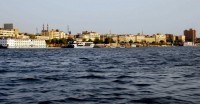
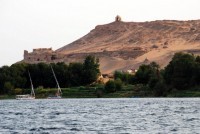
Blog post by Roderick Phillips, author of Weary Heart – a gut-wrenching tale of love and test tubes.
The post Visa hell and felucca fun, Day 292 appeared first on Roderick Phillips.
May 16, 2014
Abu Simbel, Day 291
Although we are in the heat of a Saharan summer the air-conditioner in our room at the Horus Hotel is so effective that I’m tucked into my three-season sleeping bag and in addition to my pajamas I’m also wearing a fleece. You may, quite reasonably ask why I don’t just turn off the air conditioner. The answer is that on the floor above us is an all night disco – something the fixer must have forgotten to mention – and the white noise emanating from the air-conditioner is loud enough to block out the blaring disco music. This explains why the room was so cheap – because you can’t actually sleep in it at night unless you’re willing to freeze your bits off. Perhaps the other guests are all at the disco and actually sleep during the day. To be fair Christi and I are not that inconvenienced this night because we get up in the middle of it to do a little sightseeing.
We are visiting Abu Simbel and the tour starts early, because the best time to see the temple is at dawn (god I hate these pre-dawn adventures). It is 280 km from Aswan to Abu Simbel, which takes 3.5 – 4 hours by minibus and costs US$200 for a private tour. Or you can fly there in 45 minutes and the cost is US$100 per person. Well that’s a no-brainer, but disappointingly we have to get up earlier for the flight than for the minibus. We take a taxi to the airport and have checked-in by 3.30 am. The flight should leave at 4 am, but is delayed by 45 minutes – severely cutting into our ground time at the temple. When we do get into the air (aboard an Air Memphis DC9) the journey only takes 30 minutes. We reach the Temple of Abu Simbel by 6 am and it’s still dark, which gives me a few moments to describe the miracle Christi and I have come here to witness. Abu Simbel should be at the bottom of Lake Nasser, but UNESCO intervened to save this complex. Between 1964-8 as the waters of the newly formed lake encroached ever closer to the temple, the UNESCO mission succeeded in cutting the complex into 2,000 sections, each weighing between 10 and 40 tons. These sections were then moved 210m inland and raised 65m in elevation. The sections of rock were then reconstructed inside specially designed, dome-shaped concrete mountains. It cost US$40 million dollars to save the temple complex.
The main feature of Abu Simbel is the Great Temple of the pharaoh Ramses II, comprising four 60-foot tall statues of the great man himself. Three of the statues remain, one apparently collapsed during an earthquake in 27 BC. Ramses II is often regarded as the greatest, most celebrated, and most powerful pharaoh of the entire Egyptian Empire. His reign lasted more than 66 years during the 19th dynasty of the New Kingdom (actually from 1279 BC – 1213 BC). By the legs of his statues are some of his wives and children. In fact it was Ramses 13th born son, Merneptah, that eventually succeeded him because Ramses II outlived the other twelve. Inside the temple are more statues of Ramses II, together with paintings and carvings, and of course the sanctuary housing statues of the gods and Ramses II.
Also part of the Abu Simbel complex is a smaller temple dedicated to Hathor (the goddess of love and pleasure) and Nefertari, Great Royal Wife (i.e. principal wife) of Ramses II. The rock-cut facade is decorated with two groups of colossi that are separated by the large gateway. The statues, slightly more than thirty feet high, are of the king and his queen. On either side of the portal are two statues of the king, wearing the white crown of Upper Egypt and the double crown of Upper and Lower Egypt. These are flanked by statues of the queen and the king, and uniquely in ancient Egypt the statue of the pharaoh is the same size as his wife. It is believed that these colossal statues were built as a warning to potential enemies to the south not to invade Egypt.
We leave the impressive temple complex of Abu Simbel just as the hordes of tour buses arrive. The return flight to Aswan is much smoother than the outbound flight and Christi and I are back in bed 2 hours after leaving the temple complex. We sleep in total peace (no booming disco) until 2 pm and then find our way to the Nile Ferry Company and the offices of Mr. Salah who will with a bit of luck allow us to pay an exorbitant fee for a grotty first-class room on the weekly ferry service to Sudan. He scans our beautiful travel permits…and then shakes his head. ‘Sudanese Immigration could still refuse entry,’ he complains. ‘And then I will have to bring you back to Aswan and that will cost my company money. You need to get entry visas from the Sudanese consulate here in Aswan before I can issue your tickets.’
‘I’ll keep your tickets on hold until tomorrow night. But no visa, no ticket.’
Bugger.
I seriously doubt whether Ramses II at the height of his power could have subjugated the bureaucratic behemoths that run Egypt and Sudan, but I know which side I’d be on.


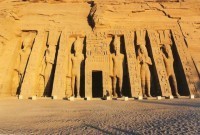
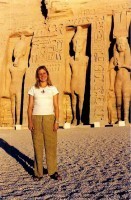
Blog post by Roderick Phillips, author of Weary Heart – a gut-wrenching tale of love and test tubes.
The post Abu Simbel, Day 291 appeared first on Roderick Phillips.
May 15, 2014
Aswan, Egypt, Day 290
Christi and I are the last to leave the Nile Story houseboat. In fact we are so popular that staff are sent to our room to give us a proper send off – or something like that. We are tossed – I mean we step gracefully – onto the dockside in Aswan, the last town of any size in Egypt. As usual it is brutally hot and the docks are largely deserted. There is, incongruously, an air-conditioned internet cafe nearby and we finally get to check out e-mail for news regarding travel permits for the Sudan. And the news is…good! Our Sudanese fixer, Midhat Mahir, has sent travel papers for both Christi and me. Yippee! We’re going to the Sudan. I’ll bet there are not many people out there who would be so excited at that news. Just call us crazy. Of course, permission to travel and actually setting foot on the vast arid desert that makes up most of the country are two different things. (Fast fact, before the creation of South Sudan, Sudan was the largest country in Africa by size. That honor now belongs to…Algeria. Nigeria is the largest by population). We still have to secure passage on the ferry from Aswan to Wadi Halfa (a port town on the banks of Lake Nasser in northern Sudan). The Nile Ferry Company is closed today, unfortunately, so that is a chore for tomorrow.
Our most pressing task today is to find accommodation in Aswan. Houseboats are lined along the river for miles and the Nile Story is moored a long way from the center of town. There is no way we’ll be walking with heavy backpacks. Fortunately we are able to flag down a taxi and for US$7 (35 LE or Egyptian pounds. LE is short for livre égyptienne, which is French for Egyptian Pound – so now you know), we are driven to the center of town. Using our trusty Lonely Planet guidebook, we check out a couple of budget options. Unfortunately prices have doubled from those in our guidebook (70LE to 140LE) and the management are not willing to negotiate. Having spent recklessly on a Nile cruise and getting into the Sudan (ferry tickets will not be cheap), Christi and I really need to economize for a bit. A fixer finds us wandering the sweaty streets of Aswan and assures he has just the place for us, and ironically it is called the Horus Hotel. The price is certainly right, 70LE, but boy is it a slum. The rooms are dingy, but they do have air-conditioning and quite excellent views over the Nile to Elephantine Island. And breakfast is included.
Aside from felucca rides on the Nile and shopping in its many souks, a visit to the Nubian Museum is the thing to do in Aswan. Historically,Nubia was a geographic entity encompassing Southern Egypt and Northern Sudan. And this museum is state of the art. This is what the Egyptian Museum in Cairo aspires too. The quality of the pieces on display are quite exquisite, if not quite as extensive as the Egyptian Museum. There are legends in English to help those of us who do not speak Arabic and there are far fewer people. All in all I’d take the Nubian Museum over the Egyptian Museum every time. There is a great exhibit on the creation of Lake Nasser and the associated cultural catastrophe that ensued as many villages had to be abandoned and many artefacts and temples now lie under water. One of the few temples to be saved from a watery grave is the temple complex of Abu Simbel (which that damn fixer persuaded us to visit tomorrow). We continue our cost-cutting endeavors by eating dinner at McDonald’s, but at least it was a McDonald’s overlooking the Nile.
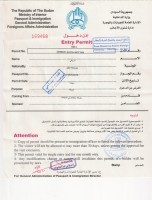
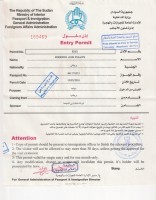
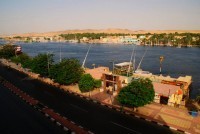
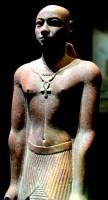

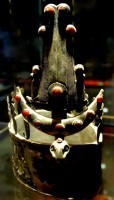
Blog post by Roderick Phillips, author of Weary Heart - a gut-wrenching tale of love and test tubes.
The post Aswan, Egypt, Day 290 appeared first on Roderick Phillips.
May 14, 2014
Nile River, Egypt, Day 289
It is quite wonderfully relaxing to float gently up the Nile. There is ample food and Christi and I have quickly trained ourselves in true Pavlovian style to respond immediately to meal times. Putting on an extra pound now might come in handy as we head deeper into Africa and the Heart of Darkness. At the moment, though, our hearts are light, bright, and happy. I try not to dwell on what will happen when we arrive in Aswan tomorrow. We will have reached the end of civilized Egypt. If we are to continue south overland (well by ferry anyway) into Sudan then life will become much tougher. And if we survive Sudan, then it’s Ethiopia and the wild open spaces of Northern Kenya. We will not reach Nairobi and the tourist trail again for at least a month. And that month is pretty much a black box. Christi and I have planned much of our Year of Wonder, but Africa is an untamed beast. We had Dragoman take the strain in West Africa, but getting from North Africa to East Africa will be up to us. From the safety of our apartment in San Francisco that sounded like a grand adventure. Now that we’re face to face with that adventure, it feels a lot more daunting. That is even assuming we can follow our preferred route into Sudan because we seriously do not have a back up plan.
The residents of the Nile delta are completely oblivious to our plight. They are much more concerned with the daily chore of finding enough food to stay alive or earning enough money to pay for essential items. There are many islands in the Nile River and people have made their homes on these fertile parcels of land. Presumably now that the Nile has been dammed south of Aswan (creating Lake Nasser), living in the middle of the river is a lot less precarious and the chances of flooding much less likely. Still a shack in the middle of the Nile seems like a dodgy proposition to me.
Egypt has an infinite number of historical artefacts and ancient temples. It is truly mind-boggling. Indeed, without such riches, many of the major museums in the world would be much emptier. If I were an Egyptian I’d be pretty angry that much of my heritage is on display in places that I will never see. Having said that, my poor brain can only soak up so much information and it’s almost full to bursting. I force myself to embrace Kom Ombo, a temple dedicated to Sobek, the crocodile-headed god of fertility, and our old friend Horus, god of war. I have to question why the ancient Egyptians used the head of a crocodile as a symbol of fertility. I don’t mean to appear sexist, but why not a gorgeous woman? If I was tasked with taking part in some sort of fertility rites, I think the ‘results’ (if you catch my drift) would be a lot more promising if my mental image was of a beautiful woman rather than a crocodile. But that’s just me.
In any event, Kom Ombo is unique in that it is dedicated to two gods and its double design meant that there were courts, halls, sanctuaries, and rooms duplicated for two sets of gods. As with the Temple of Edfu, the Temple of Kom Ombo was built during the Ptolemaic dynasty, which was the last dynasty of ancient Egypt before the Roman conquest of 30 BC. If the crowds at Edfu were impressive (and not in a good way), Kombo was dire. The trouble is all the houseboats arrive at the same time. Surely there could be a way to stagger the entrances throughout the day to dissipate the frenzy. Are you listening Egypt! And just to show the ancient practitioners of mummification were a weird lot, more than 300 mummified Nile crocodiles have been found at the site some of which are on display at the nearby crocodile museum.
I tread carefully on the way back to the Nile Story in case any of Sobek’s descendants are hanging around. This proves to be the least of our problems, though, because our boat has gone. It isn’t where we left it and there are so many boats double parked that it takes us half an hour to find its new mooring. We jump aboard just as the Nile Story sets sail for Aswan and an uncertain future.
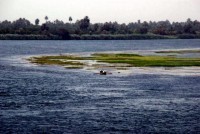
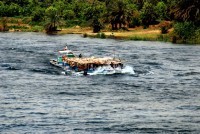

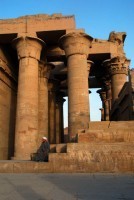
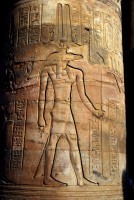

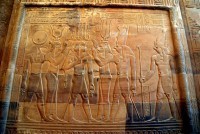

Blog post by Roderick Phillips, author of Weary Heart – a gut-wrenching tale of love and test tubes.
The post Nile River, Egypt, Day 289 appeared first on Roderick Phillips.
May 13, 2014
The Nile Story Cruise, Day 288
Christi and I were so busy enjoying the luxurious surroundings aboard the Nile Story yesterday that I forgot to mention the cruise itself. To begin with finding our houseboat at its mooring alongside the Nile at Luxor was no easy task. There are literally dozens of these massive ships docked along the river – and they are double-parked. Christi and I actually walked through the lobby of one boat to get to our own. When we step into the lobby, it is like being in a real hotel with marble floors, a carved wooden staircase, and potted plant – not to mention hurricane-force air-conditioning. Our boat is less than half-full, which may be because we’re in the shoulder between high and low season (the temperatures are only going to get hotter from here on in). Alternatively, it may be due to the world recession or the perennial troubles within Egypt. Either way we got a damn good rate, which makes the cruise all the more wonderful.
Last night the Nile Story had to pass through a lock to continue its southward journey. And we weren’t alone. There are many houseboats on both sides of the lock. Apparently in the height of the tourist season (i.e. not now thank goodness, the delay can be as much as a day or more). The Nile Story is one of three boats sitting cheek by jowl waiting to enter the lock. In fact so close are we to the neighboring boat that from our room, Christi and I gaze out at a woman sunbathing by the pool of an adjacent boat.
With a captive audience so to speak the locals use the opportunity to paddle between the mighty houseboats in tiny canoes, peddling the usual tourist junk. It’s actually an amusing distraction and the arm strength of these guys is impressive. Bagged jellabas routinely fly through the air and onto the roof-top patio of our five-story boat. Their talents are wasted here, though. Perhaps Major League Baseball should come check them out.
Food is plentiful and fairly tasty. Christi and I probably indulge a little more than the other tourists as our diets have been spartan of late. We had expected the The Nile Story staff would provide updates on tour activities at mealtimes, but it appears that each tour group brought their own guide with them and the tour guides find out the itinerary from the staff and relay the information to the passengers. Christi and I only find out what’s going from the other passengers during breakfast. The Nile Story will soon stop at the town of Edfu and there will be an opportunity to visit the Temple of Edfu. We dock with dozens of other boats and wander through a market to the actual ruins. Of course the tour guides encourage the passengers to shop for a while, allowing Christi and I to enjoy the ruins in peace…for about 5 minutes. And in actual fact the temple facade is in remarkably good shape. Construction began by Ptolemy III in 237 BC, but was not completed for 200 years (under the auspices of Ptolemy XII – father of Cleopatra). The design follows classic Pharaonic architecture from 2000 BC that was already considered archaic during the Ptolemaic times. So the Temple of Edfu is a 2000-year-old copy of a 4000-year-old original. Now that makes my head spin! The temple is dedicated to Horus, who was one of the most revered of Egyptian gods. Often depicted as a falcon-headed man, he was god of war, protection, and vengeance – so clearly not a god to mess with. There are the usual pylons (gates), sanctuaries, a Hypostyle Hall (columns), hieroglyphs, and shrines, but after 45 minutes of brutal heat and wave after wave of tourists all receiving the same historical lecture in a dozen different languages, Christi and I escape back to the Nile Story. The boat is deserted and we jump in the roof-top pool to cool off. Unlike the murky waters of the Nile up which we are sailing, the pool is clear and diamond bright. And until the tourist hordes return from Edfu, it is exclusively ours. Now this must be how it felt to be a Pharaoh back in the day.
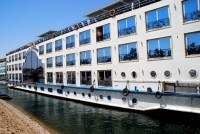
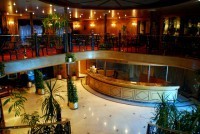
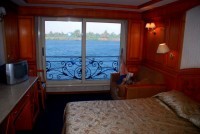

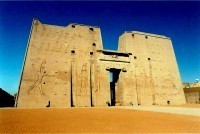

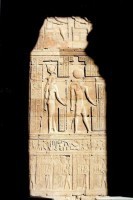
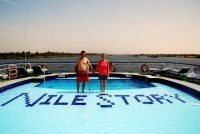
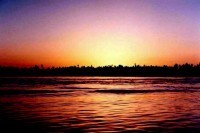
Blog post by Roderick Phillips, author of Weary Heart – a gut-wrenching tale of love and test tubes.
The post The Nile Story Cruise, Day 288 appeared first on Roderick Phillips.
May 12, 2014
The Temple Complex of Karnak, Day 287
The Temple Complex of Karnak is a hop, skip, and a jump from downtown Luxor (weather permitting). It is still incredibly hot, but Christi and I take an early morning wander up to this vast open-air museum and largest ancient religious site in the world. It is the second most popular tourist site in Egypt after the pyramids at Giza. This is hard-core Egyptology for the devotees of Ancient Egypt. It strikes me that your average tourist does not fall into this category, so why do so many people come here? Probably because the tourists are all on guided tours and boy can those tour guides drone on all day about Ancient Egypt and the Pharaohs. I think there is a fine line between gaining a sense of Ancient Egypt without feeling as if was is studying Egyptian history at degree level. Or perhaps I’m just a bit stupid because for the life of me I cannot keeps the names, dates, gods, and dynasties straight.
OK, here goes, enough Karnak trivia to entertain without being overwhelming. And we do strive to entertain here at www.roderickphillips.com. We approach the complex via an avenue of Ram-headed sphinxes. Christi breaks out the Lonely Planet guide and we start our self-guided tour (I just can’t face hiring and then disappointing these earnest and enthusiastic tour guides and my eyes will surely glaze in about 5 minutes once they start their didactic endeavors). Karnak is not your average temple complex built by a single pharaoh. Karnak evolved over 1500 years and approximately 30 pharaohs contributed to its vast construction. In fact most of the complex is not open to tourists (thank goodness), only the area called the Precinct of Amun-Re which features the magnificent Hypostyle Hall. Originally designed by Hatshepsut, the hall covers 50,000 square feet with 134 massive columns in 16 rows. Each of the papyrus-shaped stone columns are covered with hieroglyphs – not to mention some more modern-day graffiti.
During the era of the New Kingdom Karnak was the most important place of worship in Egypt and was known as Ipet-Isut (The Most Perfect of Places). Few of the individual features of Karnak are unique, but the size and number of features are overwhelming. The deities represented range from some of the earliest worshiped to those worshiped much later in the history of the Ancient Egyptian culture.
My head spins all the way back to our hotel where our fixer, Jak, organizes a transfer to our cruise ship, the Nile Story. Christi and I are a little apprehensive before boarding, wondering whether Jak has sold us down the river so to speak. Fortunately he has done us proud. The boat is magnificent and our room (number 422) is sumptuously comfortable. The bed is big and has soft white sheets just like in a hotel. There is a marble-topped desk, a couch on which to relax and either watch color TV or stare out of a tinted glass sliding door at the scenery. The scene is completed by those two most decadent of delights: air-conditioning and a gleaming bathroom with sit-down toilet. And because Christi is feeling in a decidedly decadent mood at the moment she opens the sliding door and turns on the air-conditioning and we watch life pass us by on the greatest river in Africa.

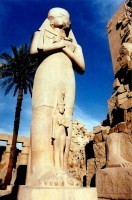
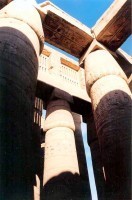
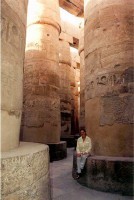
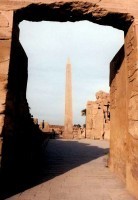
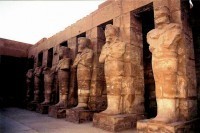
Blog post by Roderick Phillips, author of Weary Heart – a gut-wrenching tale of love and test tubes.
The post The Temple Complex of Karnak, Day 287 appeared first on Roderick Phillips.
May 11, 2014
Deir al-Bahri and the Valley of the Kings, Day 286
It’s a 7 am start for a packed day of Egyptology on the West Bank of the Nile. Our fixer at the Princess Hotel in Luxor, Jak, surprises us by providing an air-conditioned mini-van just for Christi and I. Based on prior experiences with tours in Egypt this may not prove to be the case. We double-check with Jak. A private tour of Deir al-Bahri, the Valley of the Kings, and Medinet Habu – guaranteed, he assures us. I like this guy (check him out at Jak_Jak240@hotmail.com if you need a fixer in Luxor). Our driver / guide is Sassa. He is polite and drives very carefully. He prides himself on never having had an accident with tourists (I guess this is a good thing, but what does this say about the other drivers?). We follow the course of the Nile downstream until we reach a heavily guarded bridge across the river. Egypt does take its security very seriously. Perhaps too seriously and maybe this contributed to the Arab Spring. Having said that our first destination, the funerary temple of Hatshepsut (Deir al-Bahri) has seen its fair share of troubles. In 1997, 62 people (men, women, and children) and many of them tourists were killed here by Islamist terrorists. Indeed, Egypt is enduring a two-decade long fight against terrorist activities. But on this hot morning with brilliant blue skies, Deir al-Bahri is at peace. This will not last long as hordes of tourists will be bussed in throughout the day. I take this opportunity to photograph the funerary temple of Hatshepsut, tourist-free.
Set against a backdrop of the Theban Hills, Deir al-Bahri stands as a magnificent mausoleum to perhaps the most powerful woman in history (certainly more so than Cleopatra and Margaret Thatcher). Hatshepsut was a Pharaoh of the 18th dynasty, ruling between 1473-1458 BC. She ruled initially as regent with Tuthmosis III (her nephew and the rightful heir), but she usurped his authority and took over complete power. Surprisingly she did not kill off Tuthmosis III, which may have been a mistake because when he eventually ascended to the throne (after the death of his step-mother) he ordered that her statues be defaced and her body was even removed from her mausoleum. Hatshepsut’s body was only formally identified again in 2006. One could argue that the scandal in Ancient Egypt is on a par with modern-day Hollywood!
We leave Deir al-Bahri to the tourists and move on to our next stop, Medinet Habut. It’s 10 am, hot and the tourists are out in force. The central feature of this complex is the temple of Ramses III, which is the largest temple hereabouts after the temple of Karnak. Perhaps the most impressive aspect are the abundance of reliefs that still retain their original color. As usual one is not supposed to photograph these delicate antiquities, but the local officials are happy to turn a blind eye for an appropriate ‘backsheesh’ (tip). At this point with so many facts and figures spinning through our heads, not to mention the oppressive heat we find a shady restaurant with air-con and cold drinks to wait out the excessive heat of the day.
Our last destination is the Valley of the Kings, which was used for primary burials from approximately 1539 BC to 1075 BC encompassing the 18th to 20th dynasties of the New Kingdom. The Valley contains at least 63 tombs beginning with Thutmose I and ending with Ramses XI. The reason this Valley (an arid, dusty landscape) was chosen to house the tombs of the pharaohs are manifold: (1) It was not practicable to continue building bigger and better pyramids than those found in Giza. (2). Safety. Few people lived in the West Bank, therefore there was less chance of the tombs being looted (that didn’t really work out). (3). The sun set in the west – the death of the day. (4). The A pyramidal-shaped mountain, Al Qurn, (the sign of immortality) dominates the Theban Hills hereabouts, and (5) the extremely dry conditions would help preserve the tombs and their contents. Of course most of the tombs were looted in antiquity with the exception of that of Tutankhamun. We visit a few of the tombs, including Merneptah (the son of Ramses II) and Tutankhamun. The tomb of Merneptah is huge in comparison with the boy-king. The various decorated tunnels and ante-rooms culminate in the burial chamber for Merneptah, where his stone sarcophagus remains in place. The much smaller funeral chamber of Tutankhamun is marvelously decorated and best of all the boy-king’s mummified body remains in his red quartz sarcophagus.
We’re hot, our heads are swimming with too much Ancient Egyptian history, but it has been a wonderful day hanging out with Egypt’s Pharaohs. What wouldn’t they have given for an air-conditioner back in the day!
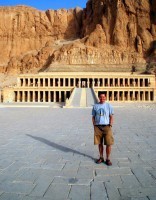


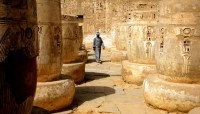
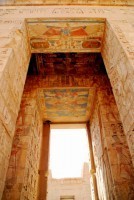
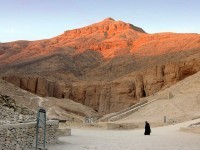
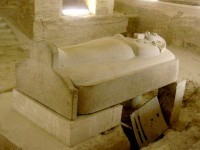
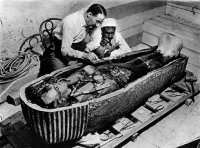
Blog post by Roderick Phillips, author of Weary Heart – a gut-wrenching tale of Love and test tubes.
The post Deir al-Bahri and the Valley of the Kings, Day 286 appeared first on Roderick Phillips.
May 10, 2014
Luxor Temple, Luxor, Day 285
Our compartment on the Cairo to Luxor train is a miniature slice of heaven. And more than anything Christi and I can lock the door and enjoy a little privacy. At least we can when Ahmed the host is not serving us dinner or later when he wants to turn our comfortable seats into two comfortable beds. Our compartment comes with a wash basin (with soap and towels) and luxury of luxuries…air conditioning. It is wonderful to be hermetically sealed in a train heading south watching the raucous life play out along the Nile. Sleep comes easily and for once a delayed arrival is most welcome. Ahmed serves us a delightful breakfast and then we brace for the onslaught of heat and fixers as we step off the train. And we’re not disappointed. It is bloody hot even at 10 am, but this does not appear to deter the fixers. What I don’t understand is how the fixers make any money. Virtually all the tourists we’ve encountered in Egypt are on some sort of organized tour and are jealously guarded by their own guides. From that perspective unaccompanied tourists must be a rare and tantalizing sight and to be honest it is too hot to argue. Christi and I succumb willingly to Jak who offers luxury rooms with air-conditioning for less than US$20 per night. And amazingly his sales pitch is actually accurate. The Princess Hotel will be our home as we explore the incredible history that surrounds Luxor: the Luxor Temple, the amazing complex of Karnak, and the West Bank tombs of the Pharaohs. And then – maybe – a cruise down the Nile to Aswan, which will either be the jumping off point for a ferry ride into Sudan or a dead-end and some serious head scratching as we decide how to continue our African odyssey.
We quickly learn that Jak and the owners of the Princess Hotel make their money on the tours. Jak positively lights up when he learns that we’re thinking of leaving Luxor by ferry. He shows us to comfortable shaded seats on the roof and brings us complimentary cold drinks (I do so like all this free stuff) and then he’s on the phone having a heated conversation in Arabic: ’180 American dollars per night for 3 nights,’ he says beaming. He might be happy, but that ends the conversation as far as I am concerned. ‘Wait, wait,’ he yells as Christi and I get up to leave. Jak paces ever more anguished during the ongoing conversation, but comes back with a much lower price – and much less enthusiasm. ’130,’ he says deflated. Even that is more than our total daily budget of US$100 per day. Believe it or not when Christi and I were planning this madcap Year of Wonder budget was our number one topic of conversation. At the time US$100 per day seemed reasonable according to prices in the Lonely Planet guide. I think has time has gone on, though, Christi and I have embraced a slightly more luxurious type of travel than backpacker class, but trying to do this on a backpacker budget is challenging. A cruise down the Nile is just too tempting to pass up, though, and while Jak’s new low price is still a budget-buster we agree.
Jak offers guided tours to the Luxor Temple and Karnak, but we intend to explore these places on our own. His last deal is the West Bank – the tombs of the Pharaohs. There’s the usual group tour rate where we’re at the whim of the guide and other tourists or…for a little extra…a private tour where we decide everything. After we agree a price Jak can’t stop smiling, which makes me think we didn’t do such a good job of negotiating this trip.
As the temperature finally begins to ease in the late afternoon we walk to the beautiful Luxor Temple located in the center of town. It is much smaller than the temple complex of Karnak apparently, but this makes the place much easier to appreciate. Luxor Temple dates to 1400 BC and in common with other temples from ancient Egypt its main function was a place to worship the myriad Egyptian gods and the Pharaoh. Indeed, maintaining the temples and building a tomb to carry the pharaoh into the afterlife were two of the most important activities in Ancient Egypt. A three-kilometer avenue of human-headed sphinxes once connected the temples of Karnak and Luxor. Remnants of that great avenue still exist leading to the entrance of the temple, which are guarded by two massive seated statues of Rameses II. Two 80-foot (25m) obelisks used to accompany them but today only one remains the other stands in the Place De La Concorde in Paris. As we explore the various courts, pylons, colonnades, the hypostyle hall, and the Holy of Holies the heat radiates off the stone and the sweat drips off of me. Photography under these conditions is challenging – I do suffer for my art – all the while I’m dreaming of an air-conditioned room at the Princess Hotel.
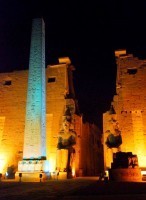

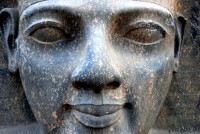



Blog post by Roderick Phillips, author of Weary Heart – a gut-wrenching tale of love and test tubes.
The post Luxor Temple, Luxor, Day 285 appeared first on Roderick Phillips.
May 9, 2014
White Desert National Park, Day 284
Christi and I are awake and moving at dawn today to explore as much of the stunning rock formations of the White Desert National Park as possible before we return to Cairo. There is no one else around – even our guide Mohammed is still fast asleep. It is quite amazing that these formations exist at all and we get to experience them in complete solitude. There is a mystical, other-worldly quality to the place, especially as the sun rises and illuminates the landscape. Science offers a less prosaic explanation that uses words likes ventifacts and aeolian particle transport, but in essence scientists believe that the chalk rocks in this area were (and continue to be) exposed to sandstorms and it is tiny sand particles within the storms that chip away at the rocks carving out the unique formations. It’s as simple as that, although sometimes natural wonders such as these do not require an explanation just admiration.
Mohammed disturbs our reverie, calling us to breakfast. As Christi and I eat he packs up the camp and then – finally – we get the tour. We visit many of the most famous rock formations within White Desert National Park, including the mushroom, the rabbit, the hen, the chisel, and the ice-cream cone to name but a few. Whoever named the chisel, by the way, clearly does not have much of an imagination! There are other magnificent formations that we simply don’t have time to see, which is so frustrating when you consider that the whole purpose of doing this tour was to explore White Desert National Park. And Mohammed does not like the time we take to photograph these unique formations.
It’s a fairly frosty ride back to the Bahariya Oasis, whereupon Mohammed begins smiling and acting friendly. He asks whether we had a good trip. I tell him we had a wonderful trip. He is pleased to hear this, but looks very disappointed when we quickly say goodbye and board the bus back to Cairo. As we wait for the bus to depart, a small group of Japanese tourists sitting behind us are hassled for a ‘backsheesh’ from another driver from the same company as our driver Mohammed.
The White Desert National Park (and the Black Desert) offer amazing scenery, but this time our tour company left a lot to be desired.
It’s another long ride back to Cairo, which is punctuated by a break at a roadside mosque so the faithful can pray. And today the bus doesn’t even return to Cairo, but kicks the passengers out at Giza. Christi and I are faced with the unpleasant prospect of taking the metro back to the Canadian hostel off Tahrir Square. Imagine our surprise, therefore, when we are greeted by someone purporting to work for the Canadian hostel who informs us that we need to get to Giza train station as quickly as possible. I’m befuddled (this doesn’t take much incidentally). We did ask Hamada (the co-owner of the Canadian hostel) to book us a sleeper compartment on an overnight train from Cairo to Luxor – but that is for tomorrow night and the train is due to leave from the main Ramses II train station in Cairo. The supposed staff member says the train leaves tonight from Giza and we need to hurry. He waves a flimsy piece of blue paper in my face, which I assume are the tickets, although I am beginning to wonder whether this is a scam organized by Amir. What I can’t fathom is how the guy is going to make money out of us. Stupidly Christi and I go with him. When we get to Giza train station he helps us carry our bags to the correct platform and gives us the tickets. He then wishes us a good trip and disappears. So the guy was for real. What a difference between Hamada’s organization and that of Amir.
We wait on the station platform with dozens of other perplexed tourists who at least have some sort of tour guide to calm their fears. Christi and I truly have no clue what is going on. Train 82, the tourist train supposedly leaves at 9.35 pm, but the only train to arrive anywhere near that time resembles a refugee express from a war-torn country overloaded with bedraggled-looking locals. We’re assured that’s not our train. Train number 82 arrives an hour late. It bears no resemblance to the local train. For a start each carriage has a besuited host who greets us and will cater to our every whim. I feel a mixture of guilt at our good fortune and relief that I’m not going to be crushed together with aromatic-smelling locals in an airless train all night following a night sleeping out in the Sahara. In fact this reminds me of a similar adventure in Mauritania. Been there, done that. Now show me the way to my luxury bed.
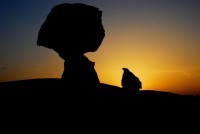
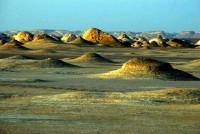


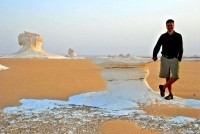
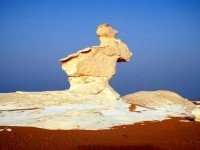
Blog post by Roderick Phillips, author Weary Heart – a gut-wrenching tale of love and test tubes.
The post White Desert National Park, Day 284 appeared first on Roderick Phillips.
May 8, 2014
Black Desert and Crystal Mountain, Day 283
The accommodation and food at our hotel in Bawiti, the largest town in the Bahariya Oasis, are quite wonderful. The people in this part of the world, including the staff at the hotel (when you can find anyone, that is. Most of the time the place is a ghost town) and our tour organizers are…challenging. It is extremely hard to get them to do what Christi and I want even though we are paying them. Quite how Amir and his outfit remain in business is beyond me. As usual we wait for hours at the hotel before Amir sends a car and driver to begin our tour of the Black Desert. His name is Mohammed…and he is not alone. There is a Japanese tourist sitting in the Toyota Landcruiser who wants to go with us. I’m not impressed and tell Mohammed to get Amir on the phone. We have a frank exchange of views. We paid for a private excursion and we’re not subsidizing other tourists. Amir is not happy to hear this, although keeping the tourists happy and sticking to the program appears to be unimportant to him. (I actually thought that sticking to the program was one of the 10 Islamic Commandments).
We leave our hotel in Bawiti hours later than anticipated in silence. Thirty minutes and 50 km down the road we enter the eerie landscape of the Black Desert. The mountains in this area have eroded to coat the desert with a layer of black powder and rocks. At the southern end of the Black Desert, previous volcanic eruptions dating back thousands if not millions of years ago leave the cone-shaped hills coated in a dark volcanic material called dolerite. Now this is why Christi and I are here. To see such unique and spectacular sights such as these. We scamper out of the Landcruiser and begin to explore. Before us is the oddly named English Mountain, which is the largest in the area. We scramble up its loose shale sides for quite breath-taking panoramic views. Truly magnificent.
A little down the road is another stop, this one is at a scummy-looking hot springs. Quite why anyone would want to jump into a hot springs when the ambient temperature is so brutally hot is beyond me, but our driver Mohammed does. And he looks very happy. Christi and I reluctantly paddle our feet. After 5 minutes I’m mentally honking a horn, but Mohammed is not to be rushed. We have one final stop before we get to the White Desert, the whole purpose of this excursion that we started almost 2 days ago if you recall, and that is the Crystal Mountain, which actually resembles more of an arch. Once upon a time, there were acres and acres of quartz crystals, but souvenir-seekers have removed many of the best examples. Still it is another unique sight. Now what about the White Desert?
We arrive in White Desert National Park after dark, set up camp and eat dinner under the stars. We’re surrounded by something magical, but we’re not quite suer what. ‘Tomorrow,’ Mohammed says before settling down for the night. I engage in another heated mental conversation with myself, although much of it is bleeped out by the censors.
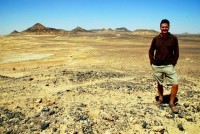
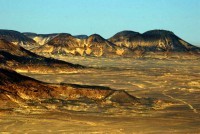
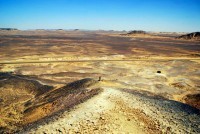
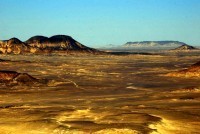
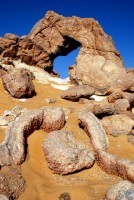
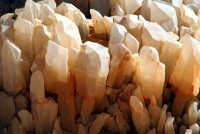
Blog post by Roderick Phillips, author of Weary Heart - a gut-wrenching tale of love and test tubes.
The post Black Desert and Crystal Mountain, Day 283 appeared first on Roderick Phillips.

